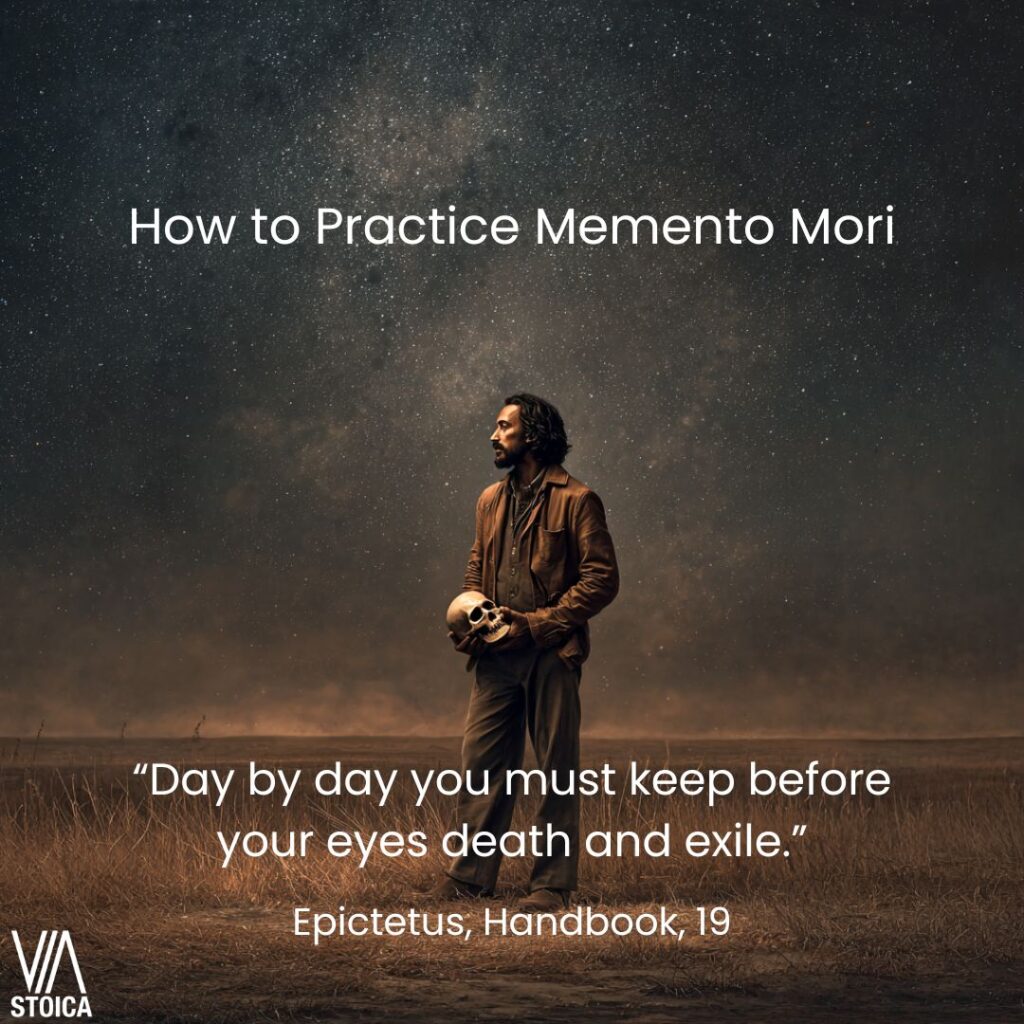What Does Memento Mori Mean?

Memento mori: “remember you must die”, is one of the most striking phrases associated with Stoicism. Strictly speaking, the Stoics never used these words. The expression itself appears centuries later, first in Christian and medieval contexts. But the practice behind it, reflecting daily on mortality, is as old as philosophy itself.
We can go all the way back to Plato, where he, in the Phaedo, has Socrates declare:
“The true philosophers are always occupied in the practice of dying, and to them least of all men is death terrible.”
Plato, Phaedo, 64a
Cicero later called philosophy a commentatio mortis, a rehearsal for death. And Montaigne, drawing from both, put it plainly:
“To philosophize is to learn how to die.”
Michel de Montaigne, The Essays, To Philosophize is to Learn How to Die
The Stoics absorbed this tradition and made it practical. Epictetus urged his students:
“Day by day you must keep before your eyes death and exile, and everything that seems terrible, but death above all; and then you will never have any abject thought, or desire anything beyond due measure.”
Epictetus, Handbook, 19
For the Stoics, remembering death is not morbid. It is a way of staying close to the essence of nature and life itself. This practice helps them focus on the present moment with gratitude and urgency.
Philosophical Grounding: Death in Stoic Thought
Death as Natural Change
Seneca insists that death is not to be feared, because it is simply part of nature:
“What is death? It is either the end, or a process of change. I have no fear of ceasing to exist; it is the same as not having begun.”
Seneca, Moral Letters, 65.24
This line is not just theory. It is an exercise in perspective. When you repeat it to yourself, you are training your soul to see death as nothing alien, nothing hostile, but the same natural process that governs birth, growth, and decline. How can something be bad if it is so in line with what the Logos, or the Rational Universe, is?
Marcus Aurelius echoes Democritus:
“The world is nothing but change. Our life is only perception.”
Marcus Aurelius, Meditations, 4.3

The practice here is to look at life through this lens: everything is flux, and our life is nothing more than a stream of impressions. Death is simply the end of that stream. Why fear the inevitable cessation of something that was always fragile?
It helps us understand what life is better. We are floating on a river that is Nature, and we get to observe, through our senses, what that world is. And while the stream will keep flowing, our journey will end and will make way for something else. Our perception is then shut.
Death as Indifferent
The Stoics place death among the “indifferents.” It is not good, it is not bad. Only virtue is good, only vice is bad. If death is not in our control, then fearing it is useless.
Epictetus challenges us bluntly:
“Death, for instance, is nothing terrible, or else it would have appeared so to Socrates too. But the terror lies in our own judgment about death, that death is terrible.”
Epictetus, Discourses, Book 2. Chapter 1.23
Here, Epictetus does not comfort. He demands that you examine the belief behind your fear. Do you think death is evil? If so, you are contradicting Socrates and the very order of nature. This is why Epictetus so often repeats: philosophy is not about fine words, but about changing the judgments that enslave us.
Meditation as Transformation
Pierre Hadot reminds us that for Marcus and the other Stoics, these were not abstract doctrines:
“We must meditate ceaselessly on death, because this meditation radically changes our way of acting, of thinking, and of feeling.”
Pierre Hadot, The Inner Citadel, Ch. 8, p. 203
This is the heart of memento mori: the practice is transformative. To recall death is to reorder your priorities. The fear of death dissolves, and life becomes urgent, precious, and aligned with nature.
Hadot calls this a spiritual exercise, not an idea to admire, but a drill to repeat, a way of living. The Stoic meditation on death is meant to change the texture of our days.
Application and Relevance Today
Why should we practice this now? Because our culture hides death. We cover it with distractions, avoid it with euphemisms, and waste our days as if we were immortal.
Seneca writes:
“It is not that we have a brief length of time to live, but that we squander a great deal of that time.”
Seneca, Dialogues and Essays, On the Shortness of Life,1
How much of your day is lost in trivial pursuits, idle scrolling, and pointless arguments? If you remembered that you are dying, not in some distant future, but today, this hour, how would you live differently?
Donald Robertson puts it sharply:
“From the moment we’re born we’re constantly dying, not only with each stage of life but also one day at a time.”
Donald Robertson, How to Think Like a Roman Emperor, Chapter 1, p. 21
Modern psychology agrees. Research on mortality awareness shows that reflecting on death can increase gratitude, sharpen focus, and bring values into clearer view. But the Stoics already knew this: death reminds us not to waste life.
Practical Exercises for Memento Mori
1. Daily Reminder of Mortality

Marcus tells himself:
“You could leave life right now. Let that determine what you do, say, and think.”
Marcus Aurelius, Meditations, Book 2.11
Practice: Each morning, write this in your journal. Before starting your day, ask: If this were my last day, would I spend it this way? Then act accordingly.
2. Contemplate the Mortality of Externals
Epictetus reminds us to extend this meditation beyond ourselves:
“If you kiss your child, or your wife, say to yourself that it is a human being that you are kissing; and then you will not be disturbed if either of them dies.”
Epictetus, Handbook, 3
Practice: When with a loved one, remember their mortality. This is not coldness. It is tenderness sharpened by awareness. Nothing deepens gratitude more than knowing it will not last.
3. The View from Above
Hadot highlights Marcus’ cosmic exercise:
“When we view things from the perspective of death, it is impossible to let a single one of life’s instants pass by lightly.”
Pierre Hadot, The Inner Citadel, Chapter 7, p. 203
Practice: Imagine your life from above, as part of the vast unfolding of nature. From this perspective, death is neither tragedy nor injustice. It is simply the recycling of matter, the return of your body to the whole.
Final Reflection
Memento mori is not about gloom. It is about freedom. To meditate on death is to train for life. It strips away the trivial and leaves what is essential.
Seneca tells us:
“He who has learned to die has unlearned slavery.”
Seneca, Moral Letters, 26.10
Epictetus would add: stop nodding in agreement and begin practicing. Philosophy is not here to soothe, but to liberate. If you meditate on death daily, you will live with urgency, gratitude, and courage.
And that is the heart of Stoicism: to live in accordance with nature, unafraid of its end.
FAQ
Did the Stoics use the phrase “memento mori”?
No. The phrase is later, but the practice of reflecting on death is central to Stoic thought.
Isn’t thinking about death depressing?
Not for Stoics. It liberates us from fear and makes life more meaningful.
How often should I practice memento mori?
Daily. Epictetus says:
“Day by day you must keep before your eyes death and exile.”
Epictetus, Handbook, 19
How is Stoic memento mori different from Christian versions?
Christianity framed it as preparation for judgment after death. Stoicism uses it as preparation for living rightly here and now.
Book a free consultation with one of our Stoic Coaches to get support. Or read more about How to Practice Stoicism here. Listen to the Via Stoica Podcast on Spotify, Apple Podcasts, or YouTube.



0 Comments